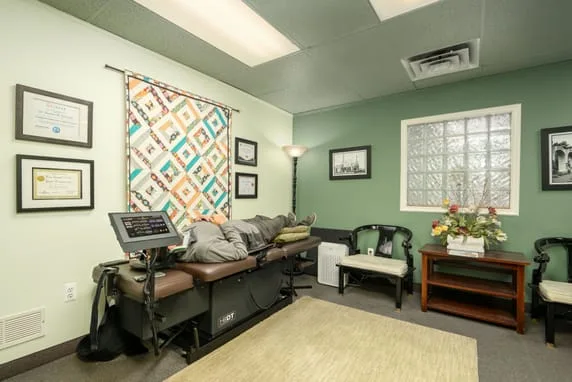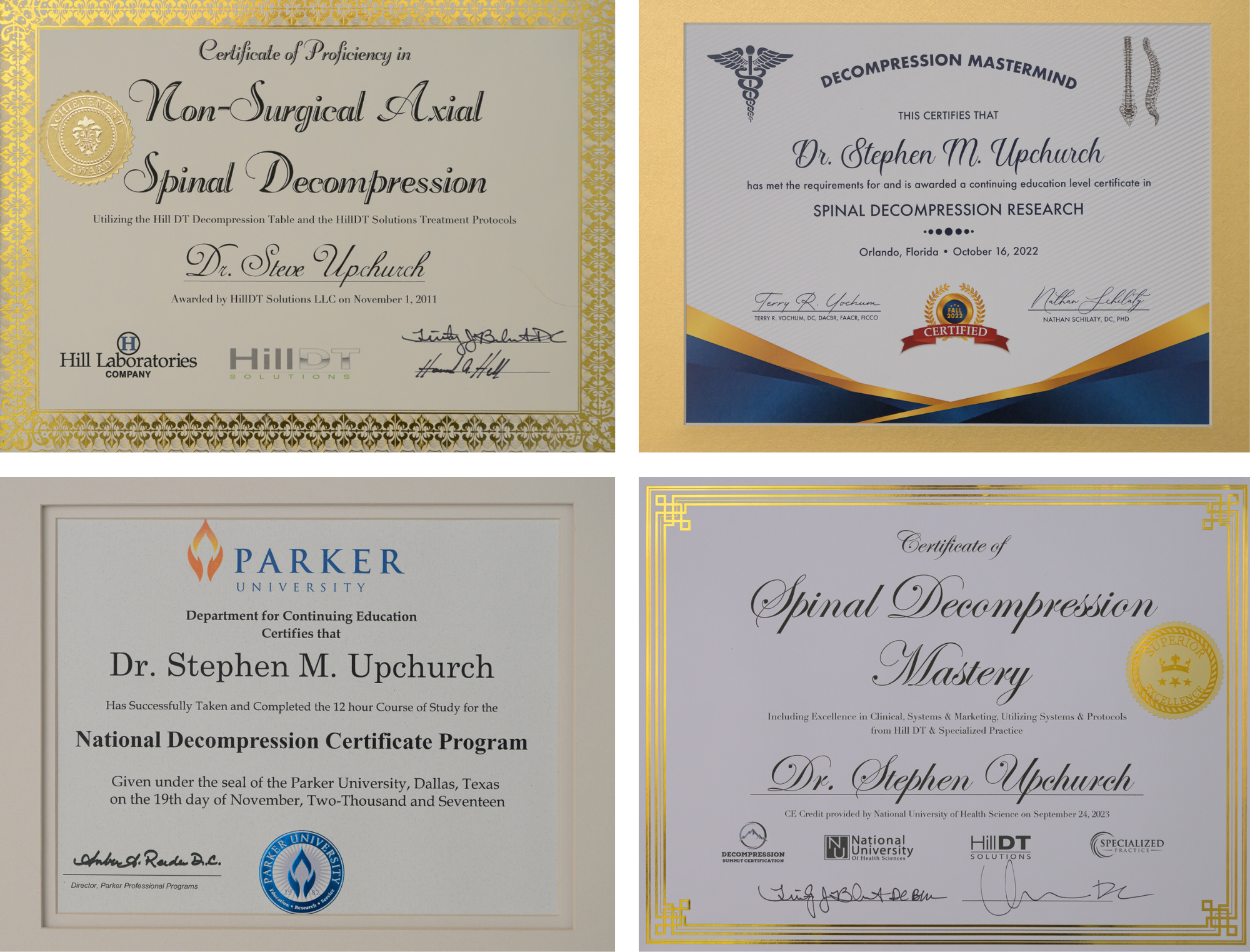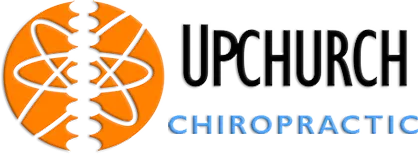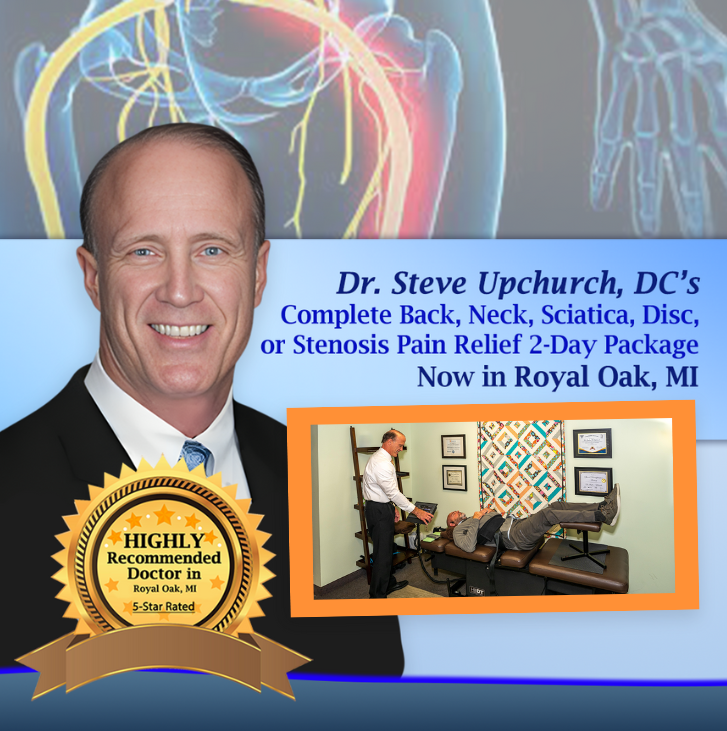
An Effective Non-Surgical Treatment for Back and Neck Pain
Non-Surgical Spinal Decompression (NSSD), also known as Spinal Decompression, is effective in treating back pain, neck pain and sciatica caused by bulging, herniated and degenerative discs or facet syndrome. Even post-surgical patients and those suffering from certain types of stenosis (a narrowing of the spinal canal) have reported significant pain relief from NSSD treatments.
Unlike Anything You’ve Ever Experienced
Non-Surgical Spinal Decompression slowly lengthens and decompresses the spine, creating negative pressures within the discs. This reversal of pressure creates an intradiscal vacuum that helps to reposition bulging discs takes pressure off pinched nerves. In Spinal Decompression employing the Hill Decompression Therapy (DT) table, the forces can be altered as to their intensity, rhythm and duration of elongation and relaxation depending upon your condition. Unlike some other decompression tables, sensors within the Hill DT table will also adjust to your body’s resistance allowing for a safe and effective delivery of decompressive forces. As a result of Non-Surgical Spinal Decompression experts believe that nutrients, oxygen and fluids are drawn into the disc to create a revitalized environment conducive to healing. This encourages the body’s innate repair mechanism, providing the building blocks needed to mend injured and degenerated discs.
We take great pride in the accolades and certifications achieved by our esteemed doctor in the field of non-surgical spinal decompression therapy. With a dedication to continuous learning, Dr. Upchurch has pursued numerous certifications and awards, showcasing a commitment to excellence in patient care. Rest assured, you are in capable hands, as Dr. Upchurch's expertise and recognition in this specialized area ensures you receive the highest standard of treatment.

How Intervertebral Discs Herniate
When pressure builds up inside the disc, it causes outward bulging of the jelly-like material inside the disc called the nucleus pulposis. With increasing or prolonged pressure, often caused by spinal misalignment, the outer ring of disc material, the annular fibers can over stretch or buckle becoming weak and unable to hold the jelly-like nucleus pulposis within the disc. This results in a bulging of the annular fibers and the possibility of eventual leaking or rupture of the nucleus pulposis.
The bulging or spilled out disc material is what puts pressure on the nerves and other structures that cause pain. This pain can travel into the buttocks and down the legs/arms or into the toes/fingers. It can cause numbness, lead to muscle and or tissue dysfunction, atrophy and nerve damage.
Are You and Candidate for Non-Surgical Spinal Decompression?
On your first visit, Dr. Upchurch will conduct a thorough history, physical exam and perform x-rays in his office to adequately determine your condition. He may possibly refer you locally for an MRI to pinpoint the specific areas of damage and discomfort. While a large percentage of low back or neck pain patients can benefit from NSSD, your examination findings will determine whether you are a candidate for Spinal Decompression. Dr. Upchurch will review the best course of care for you and give you options.
Cost of Non-Surgical Spinal Decompression (NSSD)
Regardless of insurance coverage, we provide everyone the opportunity to receive decompression therapy. We’ve eliminated your financial worry by offering payment programs which can allow you to make payments over time.
During your consultation, the doctor can give you an idea of your out of pocket costs depending upon your insurance coverage. If you choose to proceed, an examination will be performed. You will then be given a detailed report of findings in which Dr. Upchurch will inform you if you can benefit from NSSD. At that time you will receive a full explanation as to the program costs before starting care, which is dependent upon your examination findings.
At Upchurch Chiropractic, Royal Oak Spine and Disc Center, we are very concerned about your financial obligations and go out of our way to make sure you receive the best in care at a price that you can afford.
Is Non-Surgical Spinal Decompression Successful?
With the improved outcomes utilizing the Hill DT table, standard NSSD has also been found to be very successful. While Dr. Upchurch has a list of numerous studies praising the effects of NSSD, one of the largest studies done was published in the April 1998 edition of the Journal of Neurological Research.
It consisted of 778 patients in 22 separate medical centers in different geographically distinct areas in the US. Pain was rated on a scale from 0 to 5 with 5 being severe pain. The average entry level of pain was 4.2. The average length of time from onset of pain to the beginning of the Spinal Decompression was 40 months. The treatment was considered a success when the original pain was reduced to 0 to 1. Overall the SD was successful 71% of the time. Success was 73% with single herniated discs, 72% with multiple herniated discs, 68% for facet syndromes and 68% for failed back surgery.
Dr. Upchurch’s Hill DT table is a significantly more advanced decompression table than the table used in above study. Dr. Upchurch also has a list of many other studies showing the positive benefits of Non-Surgical Spinal Decompression for your review.
In Summary
This type of corrective program is results based. We will be very thorough in the evaluation of your case. We will continue to keep you informed and involved in your care. Our main goal here at Upchurch Chiropractic is to clinically improve your spine and reduce your nerve interference, thereby increasing your health and vitality.
Call our Royal Oak chiropractic office to get started with chiropractic care today!

